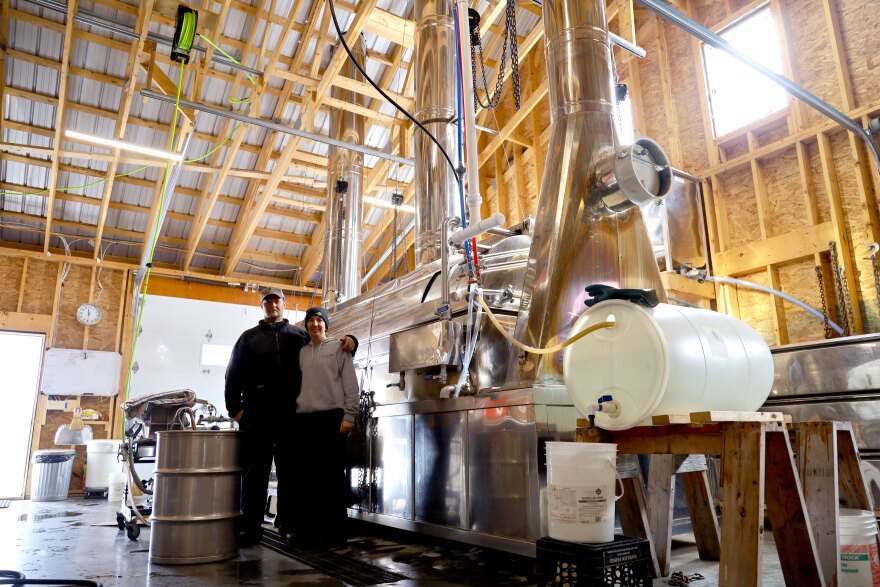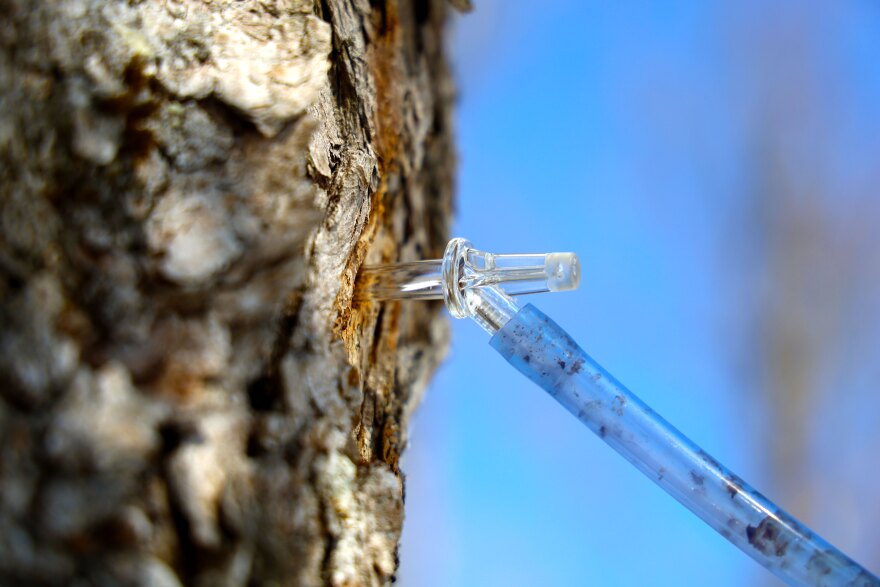Maine county may become last bastion of maple syrup producers in New England
http://https://vimeo.com/697133354
The iconic maple syrup industry is an economic driver in New England and in Maine, the third largest producer in the U.S. But rising temperatures and erratic sap runs are posing big challenges and foreshadowing even bigger changes.
If scientists’ predictions are correct, the northernmost reaches of Somerset County could become one of the last strongholds of syrup production in the region.
Donna and Jereme Frigon are aware of those dire forecasts even if their business, Gray Jay Mapleworks, is a bit more insulated from climate change. The couple leases a sugarbush from the state conservation department in Sandy Bay Township, just a couple miles south of the Canadian border.

Donna and Jereme Frigon produce about 3,200 gallons of syrup that comes from 8,000 taps that crisscross this remote sugarbush. (Esta Pratt-Kielley/Maine Public)
This is their sixth year in operation, and it’s a big step up from their humble beginnings tapping their grandparents’ trees.
“I think our best season was six gallons,” Donna Frigon said. “And that, that was a lot for the number of trees we had. I think we only had 20 trees.”
The Frigons now produce about 3,200 gallons of syrup that comes from 8,000 taps that crisscross this remote sugarbush. They’re one of many producers in northern Somerset County, the largest producing county in the entire U.S.
“In southern Maine, we’re pretty big,” Frigon said. “But here there are only a few that are smaller than us.”
A departure from tap-and-bucket
Gray Jay is also a different kind of operation than what people typically see in southern Maine, where maple syrup production is often a shoulder season crop for local farms and an attraction for families.
The Frigons run it by themselves with some help from their two children. The scale of the operation is immense and it’s far more mechanized than many operations in southern Maine and New England.

Donna and Jereme Frigon, owners of Gray Jay Mapleworks. When the sap runs the way it did in mid-March — when temperatures in Sandy Bay Township hit nearly 60 degrees — the couple works virtually nonstop. (Esta Pratt-Kielley/Maine Public)
When the sap runs the way it did in mid-March — when temperatures in Sandy Bay Township hit nearly 60 degrees — the couple works virtually nonstop.
“I have to check my records,” Frigon said between stints monitoring the evaporator and a sap boil-off that can be affected by even the slightest change in barometric pressure. “But I feel like this is early to be making this much syrup.”
Jereme kept a close eye on the reverse osmosis system that extracts about 75% of the water and minerals from sap, helping to reduce the amount of water that needs to be cooked off to get the sweet, sticky stuff.
“You get a feel for what you need to do to keep up with it and there are nights when we don’t sleep much,” Jereme Frigon said. “There are nights when we don’t sleep at all.”

Jereme Frigon standing amid tapped trees in their sugarbush. (Esta Pratt-Kielley/Maine Public)
And when they do, they sleep at the sugarhouse where they’ve constructed a triple-decker bunk bed.
Sleeping quarters are common for operations here. Arnold Farms, located directly across Route 201, has living quarters for teams of migrant workers from Guatemala. They help set the 80,000 taps that funnel sap through five video-monitored pump houses and into the sugarhouse through six miles of underground piping. The workers have constructed a makeshift soccer field out back, using branches for goals.
Arnold Farms is owned by Claude and Francois Rodrigue, a father-son duo. They’re one of many Canadian producers operating in the region. Some are here because they once worked as loggers in the Maine woods. Others because producing syrup here means not having to do so under the strict quotas and restrictions set by the Quebec Maple Syrup Producers, an organization sometimes compared to the Organization of the Petroleum Exporting Countries, or OPEC. Like OPEC, the Quebec syrup producers organization has an outsize effect on setting and stabilizing the market prices for maple syrup.
Operations like this one are already vital to Maine’s standing as the third largest syrup producer in the U.S., behind Vermont and New York.
They also could become key to the industry’s survival from climate change.
Tightening ‘maple belt’
Scientists like Andy Whitman with the environmental group Manomet believe that the area where sugar maple trees can survive and thrive is shrinking.
“It’s clear that it is shifting north, and it will continue to shift north,” he said. “Northern Maine will still be in that belt 50-100 years from now. But southern Maine will not.”

Arnold Farm Sugarhouse in Somerset County. Operations like this one are already vital to Maine’s standing as the third largest syrup producer in the U.S., behind Vermont and New York. (Esta Pratt-Kielley/Maine Public)
Whitman’s assessment largely aligns with a 2019 report by the University of Massachusetts Amherst and the U.S. Geological Survey that predicts maple syrup production in most of New England will be cut in half by the end of the century, except for places like northern Somerset County.
The problem for southern Maine and New England producers is erratic winter weather and shortening sap seasons. Whitman said researchers are already seeing the effects on smaller producers, who could find it increasingly difficult to produce enough syrup to justify the costs of production and sap harvesting.
At the same time, climate change and extreme weather events are making the region increasingly inhospitable for sensitive sugar maple trees to grow and thrive, according to Aaron Weiskittel, an associate professor of forest biometrics at the University of Maine.
Weiskittel was part of a team of researchers that four years ago analyzed decades of U.S. Forest Service Forest Inventory and Analysis data. It found that aggressive and resilient American Beech saplings are outcompeting sugar maples in several parts of New England and the trees are well positioned for climate change.
“I would say maple, sugar maple, is the most sensitive (of native hardwoods),” he said.
Red maple trees are also resilient, but there are some producers who find the sap less desirable.
For sugar maple trees in the southern part of the region, longer winters of bare ground expose root systems to wide temperature variations — extreme freezes or midwinter thaws.
This story is part of Maine Public’s series “Climate Driven: A deep dive into Maine’s response, one county at a time.”
University of Maine Cooperative Extension researcher Jason Lilley said it’s widely accepted in the industry that climate change is affecting syrup production, which is uniquely tied to weather patterns.
He said sap season is coming earlier and ending sooner, especially in southern New England, where the freeze-thaw cycle that makes for good sap runs is increasingly erratic and forcing producers to make difficult choices.
“So, it’s this very fine line of, should we tap early and catch those first two runs and potentially miss out on the quantity that we could get at the end, or not?” he said.

A tap at in a sugar maple on the property where Gray Jay Mapleworks operates. (Esta Pratt-Kielley/Maine Public)
Lilley said northern Maine looks more insulated from that kind of variability, but there’s still concern that extreme weather events like drought can also affect the health of maple trees and the quality of the sap they produce.
He said Maine producers last year didn’t see a big drop-off in sap production, but the sugar content was significantly lower than usual, which meant more sap needed to be boiled off to extract the syrup.
The working hypothesis is that the extreme drought from two years prior stressed out the maple trees, “so that there’s less photosynthesis, less sugar production from the photosynthesis and then lower sap sugar content,” he said.
The stronghold
Snowpack can help protect sugar maple root systems, and there’s plenty of it in Sandy Bay Township.
More than two feet remained in most areas in mid-March, even after three consecutive days of mild weather.
But the region is still experiencing the drought conditions southern Maine endured in 2020.
Some attribute last year’s sap output to the drought.
“A lot of sap, low sugar content, for whatever reason,” said Bill Jarvis, who manages the land where Arnold Farms sits. The landowner leases the sugarbush to the Rodriques. Timber harvesting is done on other sections.
Jarvis has been pulling crews out of the woods earlier and more frequently because mud season has come sooner.
“Like I said, the big sugar producers haven’t seen it as much, but I do on the timber harvesting side,” he said.

Claude Rodrigue working on the maple syrup production at Arnold Farm Sugarhouse. At this point in mid-March 2022, the sap is already flowing nonstop. (Esta Pratt-Kielley/Maine Public)
The Rodrigues don’t worry about the weather as much.
“I would say no. It’s different, year to year,” Claude Rodrigue said. “We finish as late now (as) 20 years ago. But each year is different. But more or less, it looks the same.”
The Rodrigues also have sap in abundance and plenty of cheap power to process it; Claude managed to get permission to run a small transmission line that delivers hydropower from Canada.
The Rodrigues said the sugar content in last year’s sap never cracked 2%, the industry standard.
But there are positive signs for this year’s first big sap run in mid-March. Sugar content in this batch of sap is already on the rise from earlier in the day.
“But I don’t know about tomorrow. We get it as we get,” Francois Rodrigue said. “We have to be very adaptive to everything that can happen.”
The same goes for Maine’s $50 million maple syrup industry, which might become concentrated in areas like Sandy Bay Township.
Producers here are gearing up for changes.
“What we are expecting is more sap at one time, as our season maybe gets smaller, or the warmups are quicker,” Donna Frigon of Gray Jay Mapleworks said. “And we’ve seen some of those runs the last few years.”
The changes have so far not altered the Frigons plans for expansion.
In fact, growing syrup production in this part of the state could be key to the industry.
Bill Patterson, the deputy director of the Maine Bureau of Parks and Lands, said the state currently allows syrup production on two properties in the area, including the operation at Gray Jay Mapleworks.
He said he didn’t believe the state had originally anticipated syrup production as a use when conserving the property. But he said the state might add it as a consideration on other conservation properties in the region.
Manomet scientist Whitman said maple trees in this area of the state might become even more productive as the effects of climate change worsen conditions in other parts of the state.
“I think Maine can continue to produce as much maple syrup as it has in the past,” he said. “It’s just that it will do that in a different place.”
Places like northern Somerset County.
Steve Mistler reported this story, and Esta Pratt-Kielley produced the video and photographs. Listen to the audio version here.
This story from Maine Public is part of special Earth Week coverage from the New England News Collaborative on how climate change is affecting food systems in our region. Visit our collection of stories here.
